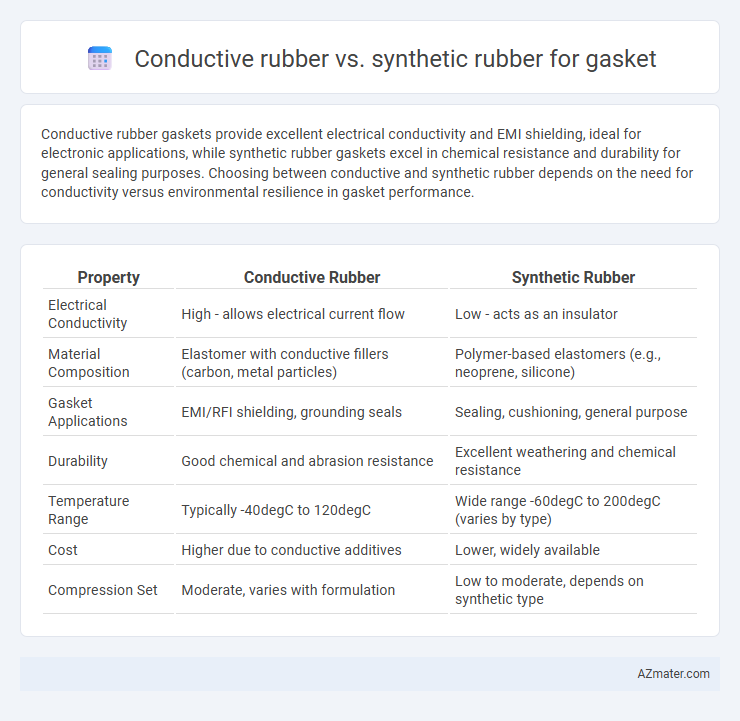Conductive rubber gaskets provide excellent electrical conductivity and EMI shielding, ideal for electronic applications, while synthetic rubber gaskets excel in chemical resistance and durability for general sealing purposes. Choosing between conductive and synthetic rubber depends on the need for conductivity versus environmental resilience in gasket performance.
Table of Comparison
| Property | Conductive Rubber | Synthetic Rubber |
|---|---|---|
| Electrical Conductivity | High - allows electrical current flow | Low - acts as an insulator |
| Material Composition | Elastomer with conductive fillers (carbon, metal particles) | Polymer-based elastomers (e.g., neoprene, silicone) |
| Gasket Applications | EMI/RFI shielding, grounding seals | Sealing, cushioning, general purpose |
| Durability | Good chemical and abrasion resistance | Excellent weathering and chemical resistance |
| Temperature Range | Typically -40degC to 120degC | Wide range -60degC to 200degC (varies by type) |
| Cost | Higher due to conductive additives | Lower, widely available |
| Compression Set | Moderate, varies with formulation | Low to moderate, depends on synthetic type |
Introduction to Gasket Materials
Conductive rubber offers excellent electrical conductivity, making it ideal for applications requiring EMI shielding or static discharge protection in gaskets. Synthetic rubber provides superior chemical resistance, flexibility, and durability, suitable for sealing in harsh environments where insulation is crucial. Selection between conductive and synthetic rubber gaskets depends on specific requirements such as electrical performance, chemical exposure, and mechanical stress.
What is Conductive Rubber?
Conductive rubber is a type of elastomer embedded with conductive fillers such as carbon, metal particles, or graphite, enabling it to conduct electricity while maintaining flexibility. It is primarily used in gaskets for electronic devices to provide electromagnetic interference (EMI) shielding and grounding capabilities. Compared to synthetic rubber, which offers general sealing and insulation properties, conductive rubber is specifically engineered to combine mechanical sealing with electrical conductivity.
What is Synthetic Rubber?
Synthetic rubber is a man-made elastomer produced through the polymerization of monomers such as styrene, butadiene, or chloroprene, offering diverse properties tailored for specific industrial applications like gaskets. Unlike conductive rubber, which incorporates carbon or metal fillers to enable electrical conductivity, synthetic rubber primarily provides excellent resistance to chemicals, oils, and extreme temperatures, enhancing gasket durability and sealing performance. Common types of synthetic rubber used in gaskets include nitrile (NBR), EPDM, and silicone, each optimized for particular environmental conditions and mechanical stresses.
Key Properties of Conductive Rubber Gaskets
Conductive rubber gaskets offer excellent electrical conductivity, making them ideal for electromagnetic interference (EMI) shielding applications compared to synthetic rubber gaskets, which prioritize flexibility and chemical resistance. Key properties of conductive rubber gaskets include low electrical resistance, high compressibility, and corrosion resistance, ensuring effective grounding and shielding in electronic devices. Their ability to maintain performance in harsh environmental conditions sets them apart in gasket applications requiring both sealing and conductivity.
Key Properties of Synthetic Rubber Gaskets
Synthetic rubber gaskets exhibit exceptional chemical resistance, flexibility, and durability, making them ideal for sealing applications in automotive, industrial, and aerospace sectors. Their excellent temperature tolerance, ranging from -50degC to 150degC, ensures reliable performance under extreme conditions. Unlike conductive rubber, synthetic rubber gaskets provide superior resistance to oils, solvents, and weathering without electrical conductivity.
Electrical Performance: Conductive vs Synthetic Rubber
Conductive rubber offers superior electrical performance for gaskets by enabling effective grounding and shielding against electromagnetic interference, which synthetic rubber lacks due to its insulating properties. The embedded conductive fillers in conductive rubber create continuous conductive pathways, ensuring lower electrical resistance and enhanced signal integrity. Synthetic rubber gaskets serve primarily as insulators, making them unsuitable for applications requiring electrical conductivity or static dissipation.
Environmental Resistance Comparison
Conductive rubber gaskets exhibit superior resistance to electromagnetic interference while maintaining moderate environmental resistance, including tolerance to oils and chemicals, but often have lower heat and UV resistance compared to synthetic rubber variants. Synthetic rubber gaskets, particularly those made from materials like EPDM or silicone, offer enhanced durability against extreme temperatures, ozone, and weather exposure, making them ideal for outdoor and high-temperature applications. Choosing between conductive and synthetic rubber gaskets depends on the specific environmental stresses, such as chemical exposure or temperature extremes, that the gasket must withstand.
Cost and Availability Considerations
Conductive rubber gaskets generally have higher costs due to specialized materials like carbon or metal fillers that enhance electrical conductivity, making them less widely available than synthetic rubber variants. Synthetic rubber gaskets, such as those made from Nitrile or EPDM, offer more economical pricing and broader availability due to mass production and common use in various sealing applications. Cost-efficiency and supply chain reliability often make synthetic rubber the preferred choice for general-purpose gaskets, while conductive rubber suits niche applications requiring EMI/RFI shielding or static dissipation.
Application Suitability: When to Use Each Type
Conductive rubber gaskets excel in applications requiring electromagnetic interference (EMI) shielding and static dissipation, making them ideal for electronic enclosures and telecommunications equipment. Synthetic rubber gaskets offer superior chemical resistance and flexibility, fitting well in automotive, industrial machinery, and fluid sealing applications. Selecting between conductive and synthetic rubber depends on specific requirements for electrical conductivity or environmental durability.
Conclusion: Choosing the Right Rubber for Gasket Needs
Conductive rubber gaskets excel in applications requiring electrical conductivity and EMI/RFI shielding, while synthetic rubber gaskets offer superior chemical resistance and flexibility for general sealing purposes. Selecting the right rubber depends on specific operational demands such as conductivity requirements, environmental exposure, and mechanical stress. Prioritizing gasket material properties aligned with these factors ensures optimal performance and longevity.

Infographic: Conductive rubber vs Synthetic rubber for Gasket
 azmater.com
azmater.com